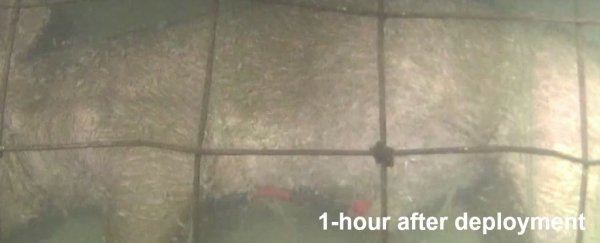Have you ever wondered what happens when you put a dead pig under 300 metres (984 feet) of water? Well, neither had we, but apparently if you're a taphonomist (someone who studies what happens to organisms after they die) figuring it out is just a regular part of your day.
A team of Canadian researchers recently submerged two pig carcasses in the Strait of Georgia - a deep body of water between Vancouver Island and mainland British Columbia - to see how they would decompose in deep water. Pig carcasses are about as similar to dead humans as you can legally get for this kind of thing, and the newly published results show that the animals' bodies - and presumably ours too - break down a whole lot faster in deep water than expected.
Although it's fascinating solely because of the gruesome morbidity of it all, the study is also important, because knowing what state a submerged body is in is crucial for rescue divers - depending on the number of days someone's been missing, they might be looking for an intact body, or a pile of bones.
The experiment was done twice, once during the Northern Hemisphere spring and again in autumn, and the pig bodies were monitored continuously by cameras and other instruments for around 150 days each time. Pigs were used because of their similarity to humans in both size, skin type, and internal bacteria.
Past studies on whales and other large marine animals have shown that some large carcasses could go through four major decomposition stages, and take decades to be completely eroded. Pigs or humans though… not so much.
 PLOS One/Gail Anderson, Lynne Bell
PLOS One/Gail Anderson, Lynne Bell
"Earlier studies in Saanich Inlet (100 metres) and Howe Sound (7-15 metres) indicate that a carcass… would be likely to survive for weeks or months, depending on oxygen levels, season, depth, and whether it remained in contact with the seabed," said criminologist Gail Anderson from Simon Fraser University. "However we've found that in highly oxygenated deeper water, it can be expected that such a body would be skeletonised in less than four days, although bones could be recovered for six months or more."
How quickly you decompose also depends on the time of year. When the team completed the experiment in spring, the carcass was reduced to bones in just four days, but in autumn, it only took three.
So why do unfortunate pigs or humans that end up in deep water decompose so much faster than marine mammals? If this experiment is anything to go by, it's because we are a tasty treat for lyssianassid amphipods, which are small shrimp-like creatures that were spotted all over the carcasses.
PLOS One/Gail Anderson, Lynne Bell
Not only were these little guys ruthless - destroying a human size carcass in three days - but instead of just eating the pig the regular way (skin first), they ate the internal organs and tissue first, literally eating the poor pig from the inside out. Yikes.
Once those guys left, it was time for the larger prawns (Pandalus platyceros) to finish off the job. Any leftover cartilage was demolished by these slightly bigger predators by day 10. After that, the poor pig really was just bones.
PLOS One/Gail Anderson, Lynne Bell
In the video below, you can see another marine visitor decided to check out what was happening about halfway through the experiment. Although that giant pacific octopus doesn't eat any of the leftovers, he does scare away many of the smaller feeders. Just remind us never to fall into a deep body of water - we like our organs where they are.
This research was published in PLOS One.
PLOS One/Gail Anderson, Lynne Bell
